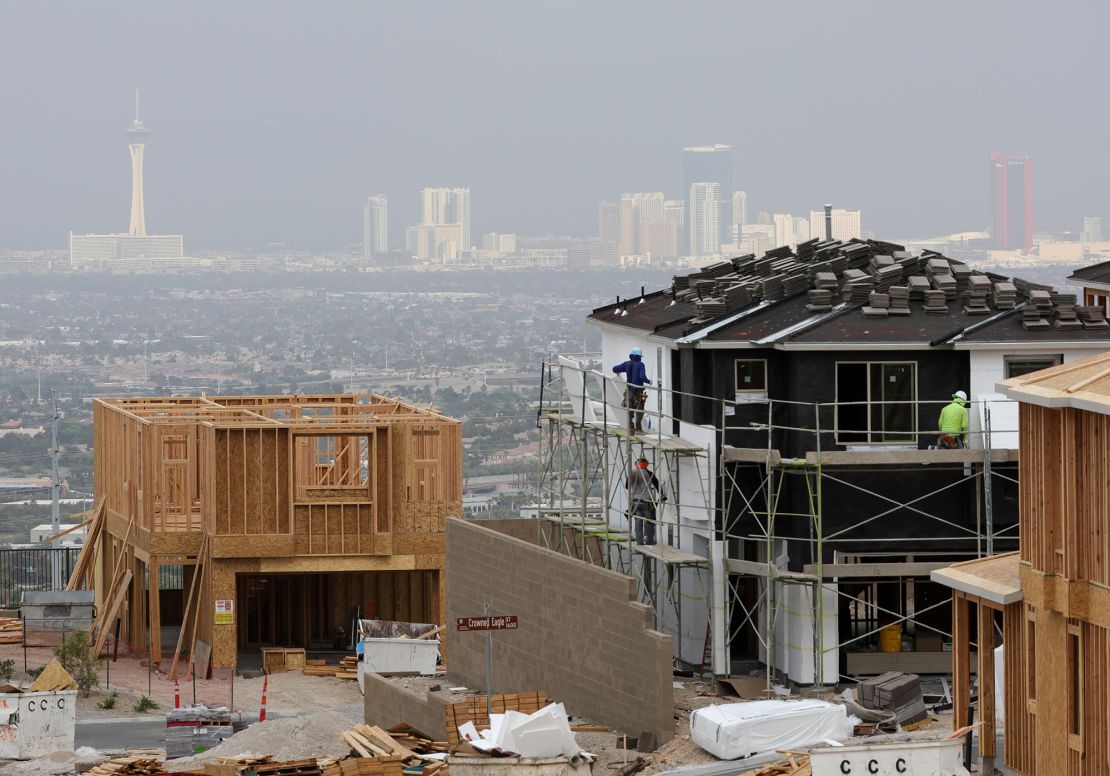When the deadly coronavirus become a global pandemic in March 2020, indoor public spaces were shuttered and stay-at-home orders were issued to ensure health and safety.
In a flash, Nevada saw its leisure and hospitality lifeblood quickly cut off.
In Las Vegas, the cacophony of voices, music, ringing slot machines and car horns that typically pulsed through the Las Vegas Strip was replaced by silence, the chirps of birds and the wails of sirens.
In Reno, John Simpson was on an emotional rollercoaster in the early months of the pandemic, not knowing whether his Press Start arcade bar could stay open or be forced to close.
“When [former Governor Steve] Sisolak finally decided we had to close, I definitely went into despair,” Simpson told CNN. “All I had worked for, sacrificed for, was gone in an instant. It felt hopeless for a long time.”
Nevada finally bounced back … big time: It’s now home to the sixth-fastest-growing economy among US states and is benefiting from both a surge in experience-centric spending and a rise in advanced technologies and logistics.
Simpson’s bar and arcade, which was founded in 2017, just finished its best year on record.
“You remember after the last pandemic what happened? The Roaring ’20s,” he said. “People are ready to get out, they’re still going out, but also the city has exploded in size.”
He added: “I’ve been waiting for this to cool off for a couple of years now; and so far, it hasn’t.”
With the spotlight on the Silver State this month as it plays host to the Republican Party-run presidential caucuses and primary this week and Super Bowl LVIII this weekend, here’s a look at the state’s economic trajectory.
Pandemic-driven spike in unemployment
In April 2020, the nation’s unemployment rate spiked to 14.8% as more than 21 million jobs were lost, Bureau of Labor Statistics data shows.
In tourism-dependent Nevada, the unemployment rate rocketed even higher, topping out at 30.6% that month. The Las Vegas metro area, which was the hardest hit in the entire nation, saw its jobless rate soar to 34%.
“If you look at all the economic indicators, like gaming revenue and visitor volume and hotel occupancy rates, they dropped off a cliff,” said Stephen M. Miller, a professor of economics at the University of Nevada, Las Vegas.
Miller, who also serves at the director of research for the Lee Business School’s Center for Business and Economic Research, added, “Because the casinos were closed, people were out of work, and if they had that extra [stimulus and unemployment] money coming in, they were not spending it and were saving it.”
He added: “They didn’t take the first job that came along, but it took a little extra time to search for a job or looking to embark on a new career ladder.”
That also explains why Nevada’s unemployment rate remains the highest in the nation, at 5.4% as of December 2023, Bob Potts, deputy director of the Nevada Governor’s Office of Economic Development, told CNN.
“This is an unemployment rate that’s not driven by job losers, this is an unemployment rate driven by job seekers,” he said. “This is an unemployment rate where there’s still momentum, there’s still opportunities for employers to find workers, and there’s still opportunity for workers to find better jobs. There’s still some mobility that’s available in our labor market.”
Another factor keeping upward pressure on Nevada’s jobless rate is the lack of affordable child care — particularly for those who work evening and overnight shifts at Las Vegas’ casinos and in other industries, including mining.
Putting a toddler in a child care center takes the biggest bite out of married Nevadans’ wallets compared to their peers in other states. The nearly $14,000 average annual cost equals 15% of median family income, according to the 2023 Annie E. Casey Foundation’s KIDS COUNT Data Book.
Meanwhile, married Nevadans who place their toddler in family- or home-based care pay about $10,500, or 11% of median family income, the second-highest share behind New Mexico, according to the foundation.
Concerned about the state’s record-low rate labor force participation rate, the Governor’s Workforce Development Board last year issued a 129-page child care policy report. It noted that because hospitality and mining are key industries in the state, around-the-clock child care is necessary.
“In Vegas, a lot of our parents are working non-traditional hours,” said Jamelle Nance, director of Strong Start Initiatives at the Children’s Advocacy Alliance of Nevada. “There are not a lot of day care providers who offer day care 24 hours a day, or in those non-traditional hours, which puts a lot of families in a bind.”
Taking care of children in the evening or overnight is costlier to provide, said Marty Elquist, director of the Supporting Early Education & Development department at The Children’s Cabinet, which administers services to support families with young children in Nevada. It is even harder to find staff and requires a different type of care.
The state is using certain Covid-19 relief funds and is undertaking other initiatives to bolster the providers offering care during non-traditional hours and to attract new ones.
“Nevada is a 24-hour state,” Elquist said. “We have to meet the needs of our workforce.”
Nevada’s housing market has roared back from the depths of the Great Recession.
When the state held its Republican caucuses in 2012, it had the dubious distinction of leading the nation in foreclosure filings and the share of homes worth less than the mortgages on them.
Now, the typical value of homes in the Silver State is 22% higher than homes in the US, according to Zillow.
The recovery has been fueled in large part by the influx of people moving to Nevada. The state has been among the faster growing in the nation, including during the pandemic.
Many of those who have relocated in recent years are working remotely for out-of-state companies or are employed in the growing tech and green energy industries in the northern part of the state, said Andrew Woods, director of the Center for Business and Economic Research at UNLV.
Nevada has proven especially popular with Californians who are looking to relocate to a lower-cost state.
“You sell any house in California, you are going to walk away with a pretty nice little profit and can put that into a house here,” said Nicholas Irwin, assistant professor of economics and real estate at UNLV.
In the Reno-Sparks area, construction’s been occurring at a “breakneck pace,” said Press Start’s Simpson, who still moonlights as an installer of fire sprinklers.
“There’s not enough people to work, still, there’s nobody to hire, wages are going up, prices are going up because we’re all so busy,” Simpson said. “That’s one of the reasons I can’t get out of it, there’s so much demand.”
Being able to purchase homes with cash is particularly advantageous in the current high-mortgage rate environment, which has put a damper on sales below the high-end range. The greater Las Vegas area, where 75% of the state’s population resides, last year saw the fewest houses sold since 2008, Irwin said.

Another factor in rising real estate values is the scarcity of buildable property in Nevada, where the federal government owns around 80% of the land. The state has fewer large plots where it can build, particularly around Las Vegas. That pushes home prices higher.
The lack of developable land is a major contributor to the affordable housing crisis in the state, said Maurice Page, executive director of the Nevada Housing Coalition. At least another 80,000 affordable units are needed.
“The biggest issue that we have is being able to find more land and being able to build,” he said.
Nevada ranks as the third-most unaffordable state for rental housing, behind Florida and Hawaii, according to a recent report from Harvard University’s Joint Center for Housing Studies. Nearly 56% of Silver State renters pay at least 30% of their household income for housing, which is considered a cost burden.
Several initiatives are underway to boost the inventory of affordable housing. In 2022, the state launched the Home Means Nevada initiative, which funnels $500 million of federal Covid-19 relief funds into building affordable multi-family housing, acquiring land for affordable housing development and preserving existing affordable multi-family housing, among other uses.
So far, about 2,800 units have been created and just under 1,100 units have been preserved, Page said.
Also in 2022, Clark County approved a $120 million effort to build or maintain 3,000 rental housing units for low-income residents. It was the first investment of its kind by a local government in Nevada. The following year, the county added $80 million to its affordable housing initiative.
The official pandemic shutdown for the state’s hotel-casino industry ended in early June 2020, but many of them were slow to fully reopen, hampered by waning tourist traffic and emerging virus variants. By December 2020, Las Vegas’ unemployment rate was still in the double digits, at 10.8%; however, Reno, its counterpart to the north, had a jobless rate that was half the size: 5.3%.
As of December 2023, the Reno metro area’s unemployment rate was just 0.2 percentage points above the nation’s 3.7% rate. Nevada and Las Vegas had rates of 5.4% and 5.1%, respectively.
Following the Great Recession, northern Nevada’s economy diversified from its gaming hub and expanded into areas such as logistics, operations, transportation, distribution, warehousing and technology.
“There was a change with the 2010 [gubernatorial] election where we really focused on economic development, and a whole bunch of things came together with the Tahoe-Reno Industrial Park, and Apple coming in, and Tesla coming in, and Panasonic coming in, and Google coming in and Switch coming in,” Potts said. “It just diversified this northern Nevada economy.”
The Southern Nevada economy, however, has been showing off some diversification of its own.
While on one end benefiting from the surge in Americans seeking experiences and spending plenty more to have those experiences (the state continues to rack up record gaming and visitor spending), Las Vegas has fully leaned into the sports entertainment industry.
In under a decade, the city has become home to four major league sports teams, six minor league teams, a major sports organization in the Ultimate Fighting Champion, four large sports venues, and significant events such as NCAA tournament games, the NFL Draft, the NFL Pro Bowl, the Formula 1 Grand Prix, and come Sunday, Super Bowl LVIII.
Potts is a firm believer that the “roadmap” from Northern Nevada can be applied to the south, given the proximity to Los Angeles and its major port. That doesn’t mean the state won’t continue to serve as a leisure and hospitality hub.
“This is not either/or, this is both/and,” Potts said. “What we want to do is be able to make it resilient so that when you start running into economic downturns, which are inevitable, there’s other industries that prop up [others].”
He added: “It’s just like a retirement portfolio: You’ve got to have bonds, you’ve got to have equity.”
Read the full article here




